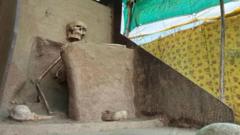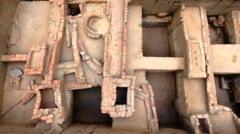The 1,000-year-old human skeleton, excavated six years ago in Gujarat, India, has finally found a permanent home at a local museum. Previously left exposed under a tarpaulin tent since 2019 due to administrative disputes, the skeleton was recently moved to the Archaeological Experiential Museum in Vadnagar.
Curator Mahendra Surela confirmed that the transportation was conducted carefully under expert supervision. Though currently placed beside the reception area within a protective barrier, plans are in motion to relocate it to the second floor for a more prominent display, which will include a photograph of the skeleton.
The skeleton, believed to date from the Solanki period (940-1300 CE), was discovered by archaeologist Abhijit Ambekar, who expressed relief that the significant find is finally receiving necessary attention. The remains are thought to offer insights into "samadhi burials," an ancient practice where revered individuals were buried instead of cremated.
For years, the skeleton’s fate was uncertain as officials debated jurisdiction, leaving it vulnerable to environmental conditions without security. It has survived remarkably well, thanks to undisturbed soil around it, maintaining qualities that are beneficial for preservation. The Archaeological Survey of India (ASI) is expected to assess further display options in due course.
Curator Mahendra Surela confirmed that the transportation was conducted carefully under expert supervision. Though currently placed beside the reception area within a protective barrier, plans are in motion to relocate it to the second floor for a more prominent display, which will include a photograph of the skeleton.
The skeleton, believed to date from the Solanki period (940-1300 CE), was discovered by archaeologist Abhijit Ambekar, who expressed relief that the significant find is finally receiving necessary attention. The remains are thought to offer insights into "samadhi burials," an ancient practice where revered individuals were buried instead of cremated.
For years, the skeleton’s fate was uncertain as officials debated jurisdiction, leaving it vulnerable to environmental conditions without security. It has survived remarkably well, thanks to undisturbed soil around it, maintaining qualities that are beneficial for preservation. The Archaeological Survey of India (ASI) is expected to assess further display options in due course.





















